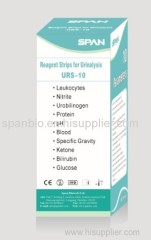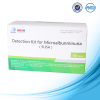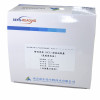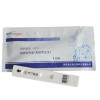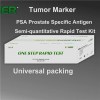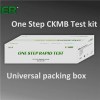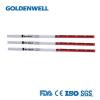As for Urine Reagent Analysis Strip Uncut Sheets , we have various parameters ranging from 1 to 12 .
We can provide you strip and uncut sheet URS format with high quality and competitive price
PRINCIPLE AND EXPECTED VALUES
URS Ascorbic acid: This test involves decolorization of Tillmann's reagent. The presence of
ascorbic acid causes the color of the test field to change from blue-green to orange.
Glucose: This test is based on the enzymatic reaction that occurs between glucose
oxidase, peroxidase and chromogen. Glucose if first oxidized to produce gluconic acid
and hydrogen peroxide in the presence of glucose oxidase. The hydrogen peroxide
reacts with potassium iodide chromogen in the presence of peroxidase. The extent to
which the chromogen is oxidized determines the color which is produced, ranging from
green to brown. Low amounts of glucose are normally excreted in urine.3 Glucose
concentrations as low as 100 mg/dL, read at either 10 or 30 seconds, may be
considered abnormal if results are consistent. At 10 seconds, results should be
interpreted qualitatively. For semi-quantitative results, read at 30 seconds only.
URS Bilirubin: This test is based on azo-coupling reaction of bilirubin with diazotized
dichloroaniline in a strongly acidic medium. Varying bilirubin levels will produce a
pinkish-tan color proportional to its concentration in urine. In normal urine, no bilirubin is
detectable by even the most sensitive methods. Even trace amounts of bilirubin require
further investigation. Atypical results (colors different from the negative or positive color
blocks shown on the color chart) may indicate that bilirubin-derived bile pigments are
present in the urine specimen, and are possibly masking the bilirubin reaction.
URS Ketone: This test is based on ketones reacting with nitroprusside and acetoacetic acid
to produce a color change ranging from light pink for negative results to a darker pink or
purple color for positive results. Ketones are normally not present in urine. Detectable
ketone levels may occur in urine during physiological stress conditions such as fasting,
pregnancy and frequent strenuous exercise.4-6 In starvation diets, or in other abnormal
carbohydrate metabolism situations, ketones appear in the urine in excessively high
concentration before serum ketones are elevated.7
URS Specific Gravity: This test is based on the apparent pKa change of certain pretreated
polyelectrolytes in relation to ionic concentration. In the presence of an indicator, colors
range from deep blue-green in urine of low ionic concentration to green and
yellow-green in urine of increasing ionic concentration. Randomly collected urine may
vary in specific gravity from 1.003-1.040. Twenty-four hour urine from healthy adults
with normal diets and fluid intake will have a specific gravity of 1.016-1.022.8 In cases of
severe renal damage, the specific gravity is fixed at 1.010, the value of the glomerular
filtrate.
URS Blood: This test is based on the peroxidase-like activity of hemoglobin which catalyzes
the reaction of cumene-hydroperoxide and 3,3',5,5'-tetramethylbenzidine. The resulting
color ranges from orange to green to dark blue. Any green spots or green color
development on the reagent area within 60 seconds is significant and the urine
specimen should be examined further. Blood is often, but not invariably, found in the
urine of menstruating females.
URS pH: This test is based on a double indicator system which gives a broad range of colors
covering the entire urinary pH range. Colors range from orange to yellow and green to
blue. The expected range for normal urine specimens from newborns is pH 5–7. The
expected range for other normal urine specimens is pH 4.5–8, with an average result of
pH 6.
URS Protein: This reaction is based on the phenomenon known as the "protein error" of pH
indicators where an indicator that is highly buffered will change color in the presence of
proteins (anions) as the indicator releases hydrogen ions to the protein. At a constant
pH, the development of any green color is due to the presence of protein. Colors range
from yellow to yellow-green for negative results and green to green-blue for positive
results. 1-14 mg/dL of protein may be excreted by a normal kidney.9 A color matching
any block greater than trace indicates significant proteinuria. For urine with high specific
gravity, the test area may most closely match the trace color block even though only
normal concentrations of protein are present. Clinical judgment is required to evaluate
the significance of trace results.
URS Urobilinogen: This test is based on a modified Enhrlich reaction between
p-diethylaminobenzaldehyde and urobobilinogen acid in strongly acidic medium to
produce a pink color. Urobilinogen is one of the major compounds produced in heme
synthesis and is a normal substance in urine. The expected range for normal urine with
this test is 0.2-1.0 mg/dL (3.5-17 µmol/L). A result of 2.0 mg/dL (35 µmol/L) may be of
clinical significance, and the patient specimen should be further evaluated.
URS Nitrite: This test depends upon the conversion of nitrate to nitrite by the action of Gram
negative bacteria in the urine. In an acidic medium, nitrite in the urine reacts with
p-arsanilic acid to form a diazonium compound. The diazonium compound in turn
couples with 1 N-(1-naphthyl)- ethylenediamine to produce a pink color. Nitrite is not
detectable in normal urine.3 The nitrite area will be positive in some cases of infection,
depending on how long the urine specimens were retained in the bladder prior tocollection. Retrieval of positive cases with the nitrite test ranges from as low as 40% in
cases where little bladder incubation occurred, to as high as approximately 80% in
cases where bladder incubation took place for at least 4 hours.
URS Leukocytes: This test reveals the presence of granulocyte esterases. The esterases
cleave a derivatized pyrazole amino acid ester to liberate derivatized hydroxy
pyrazole. This pyrazole then reacts with a diazonium salt to produce a beige-pink to
purple color. Normal urine specimens generally yield negative results. Trace results may
be of questionable clinical significance. When trace results occur, it is recommended to
retest using a fresh specimen from the same patient. Repeated trace and positive
results are of clinical significance.
Contact Rebecca Yan
Skype: span.biotech
Email: rebecca@spanbio.com
Tel: +86(755)89589611
Fax: +86(755)89580096
Web:www.spanbio.com
www.spanbiotech.com
